

Join the Fascia Conversation Today!
Fascia Lines are the intersections of the body
The concept of Fascia Lines is a great way to understand how the body functions and how treatment can be optimized to increase mobility and functionality. The main principle is that muscles, no matter what they do individually, also affect tissues throughout the entire body.
Anatomy Trains by Tom Myers is an excellent book to read with many facts about both training, exercises for mobility and the Fascia’s construction. What it is perhaps best known for is the power transmission lines also known as myofascial lines.
The lines enclose muscles, and it is sometimes described what the function of these muscles is or what type of muscle fiber the line contains. The lines are, therefore, not stand alone, but enclose organs, muscles and other tissues and parts which are included in the line.
Fascia lines according to Tom Myers
The basic hypothesis of Thomas Myers’ writings on Fascia kinetic lines is that muscles, no matter what they do individually, also affect tissues throughout the entire body through Fascia based interconnections.
These interconnections can be called Fascia lines and can be followed by the body’s dissectible “meridians” of connective tissue structures. They consist of membranes and ligaments, both superficial and deep connective tissue, loose and tight.
These Fascia lines create stability, resistance, power, flexibility, elasticity, and above all- compensatory posture. So connective tissue structures work in sync, creating a fluid and balanced movement and a posture that maintains balance and direct contact between all body parts.
In Myers book “Anatomy Trains” ligaments are described as the “inner bag” and outside them are Fascia based pathways, lines, interconnected longitudinal structures that distribute power and compensation.
The map of Fascia lines shows the longitudinal bands and loops of connective tissue including muscles and organs, which is based on the relatively new anatomical knowledge and analysis of how the musculoskeletal system really works.
The old view of muscles, the theory of “isolated muscle function” is that muscles only work between attachment and origin and mostly contracts and resists during extension. If we add on the knowledge of the Fascia’s power transmitting function, the picture is much more complex.
All tissue in the body is naturally linked to the network that the Fascia forms, but these lines are more clearly distinguishable from other tissue and appears to transmit signals / operating with more power through these pathways.
The Fascia consists of many types of collagen, elastin, retinacula fibers, and the sticky proteins called “basal lamina” or also known as the extra-cellular matrix. In this basic substance nutrient exchange and communication between cells and body parts can occur.
You can see that in parts of the body that are blocked, where muscles are locked in either a static mode, or short locked mode and skeletal parts have gotten out of position. Then, the extra-cellular matrix (basal lamina) is thinned and membranes stick together.
The collagen fibers of the Fascia builds up and becomes more stiff and locked from overload / poor mobility. As this occurs, and the basal lamina is also diluted the cells in the area does not get enough nutrition and hydration, and a vicious circle and state of illness is initiated.
The various Fascia lines
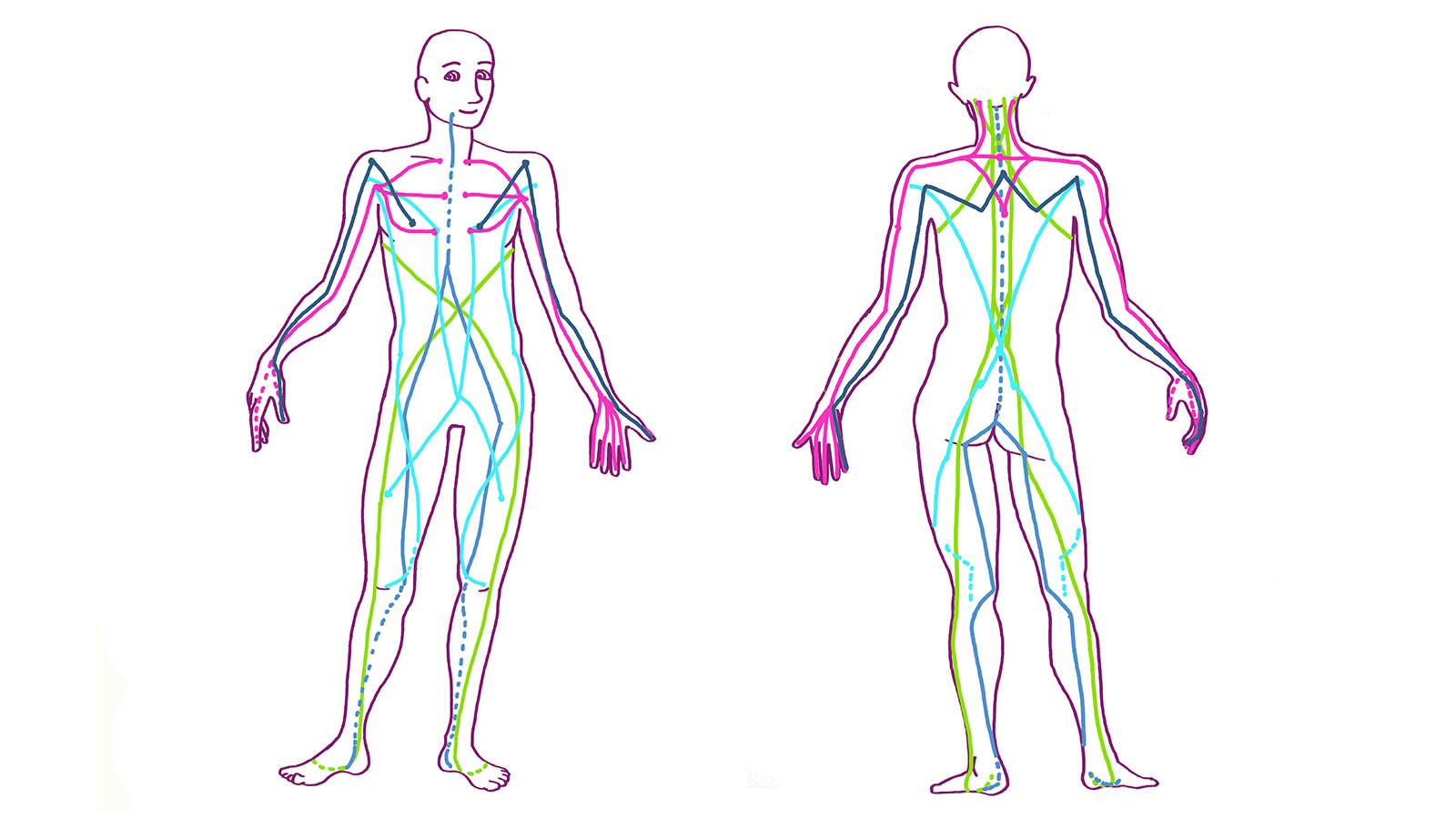
Superficial back line / Superficial dorsal line

This line connects and protects the entire rear side as a back shield, from underneath the foot to the top of the skull in two parts. From toes to knees and from the knees to the eyebrows.
When the knees are extended these two parts function as a whole.
The superficial dorsal line prevents fetal position and keeps the body upright and stretched.
We are born huddled together, but with maturity and development the superficial dorsal line and its muscles are strengthened until we have a strong upright position with raised head.
A delicate point along this line is the plantar ligament under the arch of the foot. Problems here are often propagated further up the line. (So treating the foot is very good!)
To always work along the entire superficial dorsal line helps the body towards proper balance and posture.
Superficial front line

This line connects the entire front of the body from the feet to the sides of the skull in two parts. From toes to the pelvis and from the pelvis to the skull.
When the body is upright and the hips stretched the line operates as a whole integrated Fascia.
The function of the movement is to create flexion of the torso and hips, stretch the knees and dorsal flex the foot.
The need to quickly flex up the front of various joints allows this line to contain muscles with more “fast-twitch” fibers.
Here it is also important to examine carefully as the body’s reflex to huddle together and “protect itself” is strong. Traumas can cause lock ups in the superficial front line and treatment of key parts such as the sides of the neck near the ears, front axles, hip flexors and front thighs must be done properly.
This line is often the cause of the forward tilted and rotated pelvis.
Problems after whiplash and neck strain are also quite often located here, in front of the throat which constricts and compresses the cervical spine. (Scalene, sternocleidomastoid)
Lateral line

The lateral line frames both sides of the body from the foot’s center out and inside, it extends along the outside of the leg and thigh. It passes the torso in a zigzag pattern up over the shoulder and attaches close to the ear.
The line’s influence on posture is to balance the front and rear and the lateral right-left.
The line also controls the forces transmitted from other superficial lines, superficial front and back lines, all arm lines and the spiral line.
The lateral line acts to stabilize the torso relative to the legs and helps with the coordination of movement.
The line acts in a side bending manner and lifts the hips and brakes the opposite-side’s rotations and flexions.
Here, problems often occur in the “tibia band” extending on the outside of the hip and thigh. If this part becomes short and stiff it affects the hip movement negatively and movement that is supposed to be taken with the hip will instead affect the lower back by excessive lateral movement. Many times poor mobility and numbness in the thigh’s and hip’s outside can cause back pain.
Spiral line
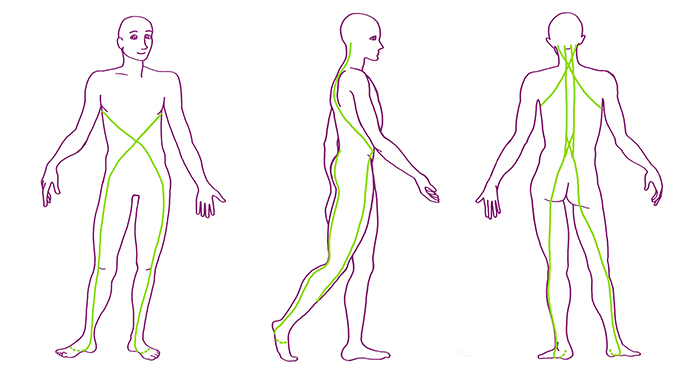
The spiral line creates a loop around the body in two opposite circles, to the right and left. It combines each side of the skull, crosses the thoracic spine back to the opposite shoulder. Then, it goes around the chest to the front to cross the navel and goes down to the hip.
From the hip the spiral line runs like a jump rope down the outside of the front thigh down to the outside of the foot. It makes a loop under the foot, continues up again towards the outer thigh more towards the rear side of the ischium. Further, onward they cross again and merge into the erector spinaes fascia.
This line stabilizes the body in all planes through its double enclosing loop. It connects the foot with the pelvis and is important in the regulation of the knee position when we walk.
When bothered this line causes rotations and imbalances throughout the body.
Fascia Arm Lines
Below are four distinct Myofascial meridians that run from the axial skeleton through four different planes in the shoulder, along all sides of the arm and to the hand out to the thumb, little finger, palm and back of the hand.
Superficial Back Arm Line & Superficial Front Arm Line
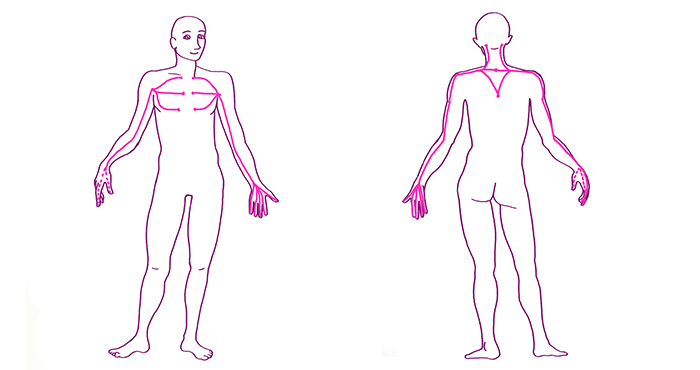
Deep Back Arm Line & Deep Front Arm Line
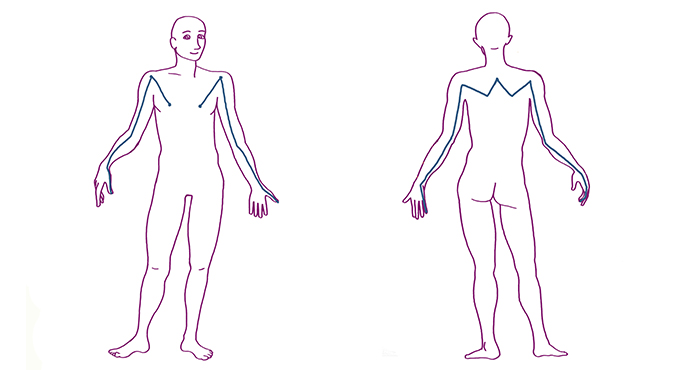
The arm lines have more cross-over structures than there are in the legs. So even if this describes longitudinal structures, they are bound together transversely as well.
This is because human arms are built to have high mobility compared to the legs that offer more stability.
To cope with this free movement more varied lines and support in all directions is required.
The arm lines is quite logically arranged with a deep and a shallow line on the front of the arm, as well as a deep and shallow one on the back of arm.
The arm lines are named after their location where they cross the shoulder. All arm lines goes unnoticed into all other lines and performs pushing, pulling, rotations, anvils and infinite movements in collaboration with the eyes in order to perform all the advanced movements we do with our arms and hands.
Functional lines
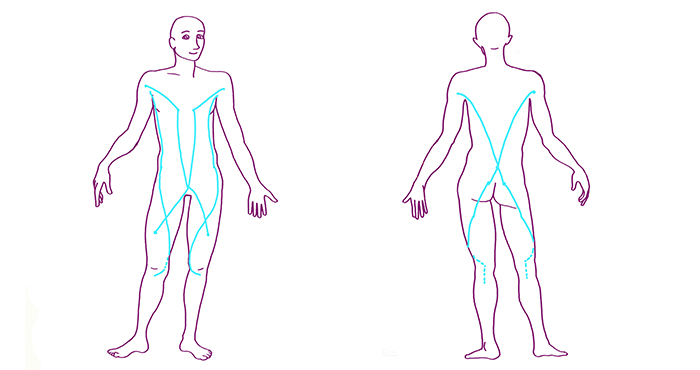
The functional lines emanate from the arm lines and cross the torso towards the opposite outer side of the pelvis and legs. Or you can say that the route goes from the opposite side as they do not have a direction.
One of the lines crosses the front and one crosses the back, so that together they form an X on both the front and backside. A third line of this group is the ipsilateral functional line, which runs from the shoulder to the inside of the same side’s knee.
These lines are activated primarily through active exercise as in sports that require a bit more stabilization, counterweight, or getting power from your opposite side.
An example is a powerful baseball throw where the thrower draws strength from the ground and then pushes power up diagonally to the throwing hand, or a tennis player’s backhand.
These lines are less active in the standing position.
Deep front line
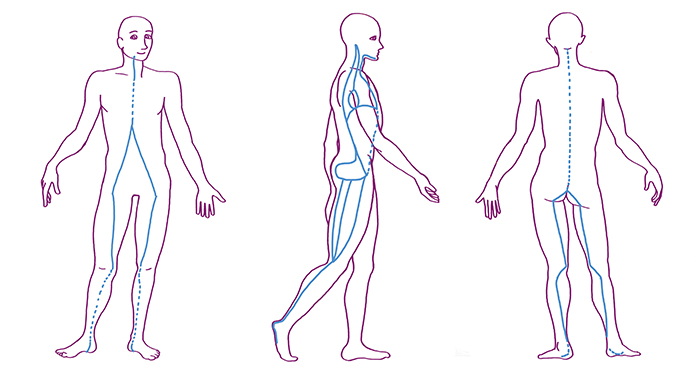
The deep front line is located between the right and left lateral lines in the front plane, wedged between the superficial front line and superficial dorsal line in the sagittal plane. It is surrounded by the spiral lines and functional lines.
The deep front line includes the body’s Myofascial “core”. If we start from the bottom the line has deep roots under the foot, passing up the skeleton of the back leg, behind the knee and inner thigh. From here, a larger track runs through the hip, pelvis and lumbar vertebrae front while an alternative pathway runs along the back of the thigh to the pelvic floor after which it returns with the first part at the lumbar vertebrae.
Further upward through the diaphragm the deep front line passes up through the chest with many branches through the thoracic viscera and ends on the bottom of both the neuro cranium and the visceral cranium.
This line is the most three-dimensional in shape rather than a line. All lines are of course partly three-dimensional, but they are more like power transmission lines.
The deep front line definitely takes up more space than other lines. In the legs the deep front line envelops most of the stabilizing muscles. Through the hip the line has a close relation to the hip joint and synchronizes the rhythm of our walk with the rhythm of our breathing.
In the torso the deep front line along with the autonomic ganglia, runs between our neuromotor chassis and the organs that supports cells in the ventral chest cavity.
In the neck the deep frontal line provides counterbalance to the pulling mechanisms that the superficial front and back line causes.
An in-depth understanding of this line is essential for the successful treatment in almost all types of manual techniques and therapies.
The deep front line …
- Shifts the inner arc
- Stabilizes all segments of the legs, including the hip.
- Supports the lumbar front
- Envelops and shapes the abdomen’s and pelvis’ interior.
- Stabilizes the chest, while offering expansion and relaxation for breathing.
- Balances the fragile neck and heavy head.
The deep front line contains mostly persevering stabilizing muscle fibers and works to stabilize with a firmer form of Fascia. Decreased function in the deep front line can be the cause of recent injuries and complicated issues that are not easily treated away.




















































